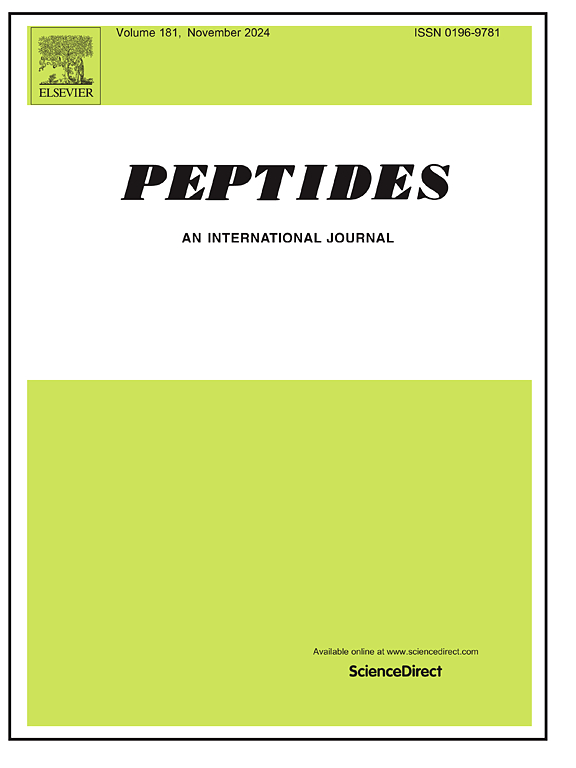Membrane alteration, anti-virulence properties and metabolomic perturbation of a chionodracine-derived antimicrobial peptide, KHS-Cnd, on two bacteria models
IF 2.9
4区 医学
Q3 BIOCHEMISTRY & MOLECULAR BIOLOGY
引用次数: 0
Abstract
Antarctic fishes, living in an extreme environment and normally exposed to pathogens, are a promising source of antimicrobial peptides (AMPs). These are emerging as next-generation drugs due to their activity against multidrug resistant (MDR) bacteria. To infect hosts, beyond intrinsic/acquired resistance, MDR species also use virulence factors such as protease secretion. Hence, AMPs targeting virulence factors could represent a novel strategy to counteract the antimicrobial resistance (AMR). In this paper, we focused on a mutant peptide, named KHS-Cnd, that was obtained from the scaffold of the chionodracine (Cnd), a natural peptide identified in the icefish Chionodraco hamatus. We studied different effects caused by the peptide interaction with the cell membrane of two model bacteria, E. coli and B. cereus. First, we investigated its membranolytic activity revealing that the peptide action is more evident on E. coli, with a 69 % uptake of the used dye at 3 μM, whereas for B. cereus we found only a 65 % uptake at 6 μM. Successively, we determined the impact of this lysis on total protein concentration in the medium and an increase was estimated for both bacteria (84 % after 1 h for E. coli and 90 % for B. cereus, respectively). Moreover, we evaluated the changes in the proteolytic activity of the supernatant, that is an important aspect of bacterial resistance, showing that there was a significant reduction for both bacteria, although at higher level in the case of E. coli. The membranolytic activity was evidenced also morphologically with TEM analysis and a different alteration was evidenced for the two bacteria. Moreover, NMR metabolomics analysis showed that peptide induces changes in E. coli and B. cereus extracellular metabolites especially at the higher tested concentrations: this metabolic variation could be used as a fingerprinting of the peptide action on bacteria physiology due to its interaction with cell wall. Finally, we determined the KHS-Cnd cytotoxicity on human primary cell lines to verify its selectivity toward bacterial cell membranes and we found low toxicity until a concentration of 5 μM. Considering that the peptide exerts both membranolytic and anti-virulence activity on E. coli at 1.5 μM, we confirmed the interesting potential of this AMP as a new drug to counteract AMR.
一种源自chionodracine的抗菌肽KHS-Cnd对两种细菌模型的膜改变、抗病毒特性和代谢组扰动。
南极鱼类生活在极端环境中,通常会接触到病原体,是抗菌肽(AMPs)的重要来源。由于其对耐多药(MDR)细菌的活性,这些抗菌肽正在成为下一代药物。为了感染宿主,除了内在/获得性抗药性外,MDR 菌种还利用蛋白酶分泌等毒力因子。因此,以毒力因子为目标的 AMPs 可能是对抗抗菌药耐药性(AMR)的一种新策略。在本文中,我们重点研究了一种名为 KHS-Cnd 的突变肽,这种肽是从冰鱼 Chionodraco hamatus 发现的天然肽 chionodracine (Cnd) 的支架上获得的。我们研究了该肽与两种模式细菌(大肠杆菌和蜡样芽孢杆菌)的细胞膜相互作用所产生的不同效果。首先,我们研究了肽的膜溶解活性,发现肽对大肠杆菌的作用更为明显,在 3 μM 的浓度下,所用染料的吸收率为 69%,而在 6 μM 的浓度下,对蜡样芽孢杆菌的吸收率仅为 65%。随后,我们测定了这种裂解对培养基中总蛋白质浓度的影响,结果发现这两种细菌的蛋白质浓度都有所增加(1 小时后大肠杆菌和蜡样芽孢杆菌的蛋白质浓度分别增加了 84% 和 90%)。此外,我们还评估了上清液蛋白水解活性的变化(这是细菌抵抗力的一个重要方面),结果显示两种细菌的蛋白水解活性都显著降低,但大肠杆菌的蛋白水解活性更高。膜溶解活性还通过 TEM 分析得到了形态学上的证明,而且两种细菌都发生了不同的变化。此外,核磁共振代谢组学分析表明,肽会引起大肠杆菌和蜡样芽孢杆菌胞外代谢物的变化,尤其是在测试浓度较高的情况下:这种代谢变化可用作肽与细胞壁相互作用对细菌生理作用的指纹图谱。最后,我们测定了 KHS-Cnd 对人类原代细胞系的细胞毒性,以验证其对细菌细胞膜的选择性。考虑到该肽在 1.5 μM 浓度下对大肠杆菌具有溶膜和抗病毒活性,我们证实了这种 AMP 作为抗 AMR 新药的有趣潜力。
本文章由计算机程序翻译,如有差异,请以英文原文为准。
求助全文
约1分钟内获得全文
求助全文
来源期刊

Peptides
医学-生化与分子生物学
CiteScore
6.40
自引率
6.70%
发文量
130
审稿时长
28 days
期刊介绍:
Peptides is an international journal presenting original contributions on the biochemistry, physiology and pharmacology of biological active peptides, as well as their functions that relate to gastroenterology, endocrinology, and behavioral effects.
Peptides emphasizes all aspects of high profile peptide research in mammals and non-mammalian vertebrates. Special consideration can be given to plants and invertebrates. Submission of articles with clinical relevance is particularly encouraged.
 求助内容:
求助内容: 应助结果提醒方式:
应助结果提醒方式:


